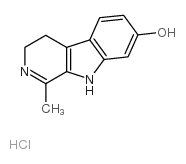CHEMICAL IDENTIFICATION
-
RTECS NUMBER :
-
UV1047000
-
CHEMICAL NAME :
-
3H-Pyrido(3,4-b)indol-7-ol, 4,9-dihydro-1-methyl-, monohydrochloride
-
CAS REGISTRY NUMBER :
-
6028-07-5
-
LAST UPDATED :
-
198608
-
DATA ITEMS CITED :
-
6
-
MOLECULAR FORMULA :
-
C12-H12-N2-O.Cl-H
-
MOLECULAR WEIGHT :
-
236.72
-
WISWESSER LINE NOTATION :
-
T656 BM EN DUT&&J D1 LQ
HEALTH HAZARD DATA
ACUTE TOXICITY DATA
-
TYPE OF TEST :
-
LDLo - Lowest published lethal dose
-
ROUTE OF EXPOSURE :
-
Intraperitoneal
-
SPECIES OBSERVED :
-
Rodent - mouse
-
DOSE/DURATION :
-
230 mg/kg
-
TOXIC EFFECTS :
-
Details of toxic effects not reported other than lethal dose value
-
REFERENCE :
-
QJPPAL Quarterly Journal of Pharmacy & Pharmacology. (London, UK) V.2-21, 1929-48. For publisher information, see JPPMAB. Volume(issue)/page/year: 3,218,1930
-
TYPE OF TEST :
-
LDLo - Lowest published lethal dose
-
ROUTE OF EXPOSURE :
-
Subcutaneous
-
SPECIES OBSERVED :
-
Rodent - mouse
-
DOSE/DURATION :
-
380 mg/kg
-
TOXIC EFFECTS :
-
Details of toxic effects not reported other than lethal dose value
-
REFERENCE :
-
QJPPAL Quarterly Journal of Pharmacy & Pharmacology. (London, UK) V.2-21, 1929-48. For publisher information, see JPPMAB. Volume(issue)/page/year: 3,218,1930
-
TYPE OF TEST :
-
LD50 - Lethal dose, 50 percent kill
-
ROUTE OF EXPOSURE :
-
Intravenous
-
SPECIES OBSERVED :
-
Rodent - mouse
-
DOSE/DURATION :
-
100 mg/kg
-
TOXIC EFFECTS :
-
Details of toxic effects not reported other than lethal dose value
-
REFERENCE :
-
CSLNX* U.S. Army Armament Research & Development Command, Chemical Systems Laboratory, NIOSH Exchange Chemicals. (Aberdeen Proving Ground, MD 21010) Volume(issue)/page/year: NX#03207
-
TYPE OF TEST :
-
LDLo - Lowest published lethal dose
-
ROUTE OF EXPOSURE :
-
Subcutaneous
-
SPECIES OBSERVED :
-
Rodent - rabbit
-
DOSE/DURATION :
-
300 mg/kg
-
TOXIC EFFECTS :
-
Behavioral - muscle weakness Cardiac - pulse rate Lungs, Thorax, or Respiration - respiratory depression
-
REFERENCE :
-
QJPPAL Quarterly Journal of Pharmacy & Pharmacology. (London, UK) V.2-21, 1929-48. For publisher information, see JPPMAB. Volume(issue)/page/year: 3,218,1930
-
TYPE OF TEST :
-
LDLo - Lowest published lethal dose
-
ROUTE OF EXPOSURE :
-
Subcutaneous
-
SPECIES OBSERVED :
-
Rodent - guinea pig
-
DOSE/DURATION :
-
300 mg/kg
-
TOXIC EFFECTS :
-
Details of toxic effects not reported other than lethal dose value
-
REFERENCE :
-
QJPPAL Quarterly Journal of Pharmacy & Pharmacology. (London, UK) V.2-21, 1929-48. For publisher information, see JPPMAB. Volume(issue)/page/year: 3,218,1930
-
TYPE OF TEST :
-
LDLo - Lowest published lethal dose
-
ROUTE OF EXPOSURE :
-
Subcutaneous
-
SPECIES OBSERVED :
-
Amphibian - frog
-
DOSE/DURATION :
-
250 mg/kg
-
TOXIC EFFECTS :
-
Behavioral - rigidity (including catalepsy) Lungs, Thorax, or Respiration - respiratory depression
-
REFERENCE :
-
QJPPAL Quarterly Journal of Pharmacy & Pharmacology. (London, UK) V.2-21, 1929-48. For publisher information, see JPPMAB. Volume(issue)/page/year: 3,218,1930
|


